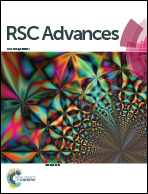Shear behavior at high pressures and viscoelastic properties in water and in brine solutions with high salinities for a tetra-polymer containing poly(ethylene oxide) side chains
Abstract
A novel tetra-polymer (PASV) was synthesized using acrylamide(AM), vinyl biphenyl (VP), sodium 2-acrylamido-2-methylpropane sulphonate (NaAMPS), and a novel salt-tolerant macromonomer, allyl-capped octylphenoxy poly(ethylene oxide) with the polymerization degree of 4 (AE). Consecutive shear behaviors of PASV were investigated at high pressures of 5–20 MPa as well as atmospheric pressure to reveal rheological performance of oil-flooding polymers in oil reservoirs. PASV displays an excellent thickening effect induced by salt as well as good associated behavior in aqueous solutions. Its critical association concentrations are merely 0.7 g L−1 and 0.6 g L−1 in aqueous solution and in 70 g L−1 NaCl, respectively. PASV in 70 g L−1 NaCl exhibits not only obvious shear thickening behavior but also unreported pressure-thickening behavior in an investigated pressure range of atmospheric pressure to 20 MPa at 65 °C. PASV also displays predominantly unexpected elastic behavior both in water and in brine solutions with high NaCl concentrations.



 Please wait while we load your content...
Please wait while we load your content...